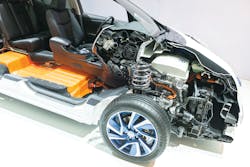The business community likes change to come at a slow pace, and to be able to exert enough control so that it can stay in front of evolving events.
When it comes to the transition from internal combustion to electric power for cars and trucks, the industry is in for a wild ride.
The Biden administration’s recent proposal to use Environmental Protection Agency (EPA) emissions regulations to speed up the transition to electric vehicles (EVs) means manufacturers — particularly plastics resin makers and processors — are going to be under pressure to deliver products at a much faster rate than at any other time in automotive history.
For more than a century, automakers took years to develop new models. Suppliers were brought into the process with plenty of time to develop their contributions to the new model. Once production began, suppliers could depend on seven to 10 years of steady work from the model.
The latest proposals from the Biden administration would have 67 percent of cars and light-duty trucks sold in the U.S. produce zero emissions by 2032. Some 46 percent of medium-duty trucks would be all-electric by 2032. The tougher standards would kick in in 2027 and ramp up to the final total in 2032.
A second proposal would require 50 percent of new buses and 25 percent of heavy-duty trucks, including 18-wheelers, to be all-electric by 2032.
The plastics industry is absolutely essential to the transition to zero-emission vehicles. Chris Jahn, president and CEO of American Chemistry Council (ACC), said this in reaction to the tougher standards: “The products and technologies made possible by America’s chemical manufacturers and plastics makers are vital to achieving better vehicle fuel efficiency, reduced GHG [greenhouse gas] emissions and any transition to EVs. EV infrastructure, charging stations, batteries, battery housings, closures, encasements, connectors — just to name a few — all rely on critical inputs made possible by chemical and plastics products.”
Jahn called on the administration and Congress to adopt regulations that do not stifle the industry.
Last year, all-electric vehicles made up only 5.8 percent of new cars sold domestically. All-electric trucks were just 2 percent. The EPA cannot dictate the number of EVs each automaker sells, but it can set limits under the Clean Air Act that forces automakers to sell a certain number of zero-emission vehicles to meet the regulation or face billions in fines.
But from 5.8 percent of cars sold in 2022 to 67 percent in 2032 is a huge leap.
Speeding up the transition will probably turn out to be a good thing for the automotive industry in the long term. The number of years it must produce both powertrains will be reduced, and consumers could be forced to overcome some of their objections to EVs sooner. The accelerated transition also reduces harm to the environment as pollution from internal combustion engines is eliminated.
But parts suppliers are going to get whipped around like the last person in a string of skaters going faster and faster in a circle. They are going to have less time to develop the products required for new car models. The amount of time to get an approved part into production is going to be shorter. And those long, seven-year production runs will probably be a thing of the past.
There are likely to be legal challenges to the new rules, but I suspect in the end automakers will gear up and achieve the standards. That is the scenario that played out many years ago when corporate fuel mileage standards were first imposed.
As of this writing, no automaker has objected to the proposal. The United Auto Workers has expressed concern that the changes are happening too quickly and could endanger jobs.
Don’t be surprised if some plastics processors decide to reduce their automotive business or exit it altogether in favor of end markets that are more stable. The ones that stay and thrive will need to become more flexible.
Even though parts runs for EVs could be shorter in the near future, automation will likely play a bigger role. To be flexible, processors might need to depend much more on 3D printing, quality control utilizing vision equipment and some operations that are run by artificial intelligence.
Processors making automotive parts also will need to work much more closely with materials developers. It is a brave new world for them, as well.
Some processors will turn to molding simple, long-lasting products. But others will embrace the fast pace of change and thrive by adapting their manufacturing businesses to a new model.
Ron Shinn, editor
About the Author
Ron Shinn
Editor
Editor Ron Shinn is a co-founder of Plastics Machinery & Manufacturing and has been covering the plastics industry for more than 35 years. He leads the editorial team, directs coverage and sets the editorial calendar. He also writes features, including the Talking Points column and On the Factory Floor, and covers recycling and sustainability for PMM and Plastics Recycling.
